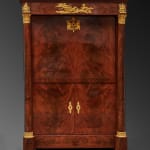Jacob-Desmalter et Cie (attributed to)
A superb quality Empire gilt bronze mounted mahogany secrétaire à abattant attributed to Jacob-Desmalter et Cie with superb mounts attributed to either Pierre-Philippe Thomire or Claude Galle. The moulded rectangular grey veined marble top above a frieze centred with a gilt bronze mount depicting Cupid in his chariot riding over clouds and pulled along by tethered butterflies, flanked at either end of the frieze by seated classical maidens above turned columns mounted with foliate capitals and conforming gilt bronze mounts at their bases. The upper fall-front door featuring a central escutcheon comprised of a pair of classical maidens amid scrolls below a vase filled with flowers, the fall-front door opening to reveal a gilt tooled brown leather writing surface, the interior with an upper open compartment flanked by mounted pilasters above two central drawers and three smaller drawers either side. The fall-front above a pair of doors each with a foliate escutcheon, the plain rectangular base flanked by rounded columnar feet
Paris, date circa 1810-15
In keeping with other works by the esteemed firm of ébénistes Jacob-Desmalter et Cie, this secrétaire is of the highest quality and like much of their furniture it is made of the finest mahogany, offset by superb mounts. Jacob-Desmalter often favoured exotic veneers such as distinctively figured mahogany, which were carefully selected so as to display its natural grain - in this instance a symmetrical radiating flame pattern. Such a large expanse of mahogany would have been very costly. It perfectly offsets the gilt bronze mounts which were almost certainly supplied by either Pierre-Philippe Thomire (1751-1843) or Claude Galle (1759-1815). The firm took great care in choosing the best quality mounts, which not only combined great design and fine detail but as here often incorporated symmetrically aligned figural escutcheons. Interestingly the central frieze mount showing Cupid in his chariot pulled by butterflies corresponds with certain pieces by the ébéniste Bernard Molitor (1755-1833), notably on a commode of circa 1808-14, illustrated in Ulrich Leben, “Molitor, Ebéniste from the Ancien Régime to the Bourbon Restoration”, 1992, p. 184, catalogue no. 34 (sold at Douot, Paris 7th May, lot 108). The same mount but in reverse again features on another unstamped but attributed Molitor commode, which was acquired in Paris for King Jérôme for Schloss Wilhemshöhe, Kassel (illustrated ibid., p. 183, cat. no. 33A). Leben notes the difficultly in linking Molitor’s mounts to a specific fondeur but in relation to the furniture supplied to the Imperial Garde-Meuble for King Jérôme one can cite Pierre-Philippe Thomire as well as Claude Galle, either of whom may well have made the present mounts.
Jacob-Desmalter at rue de Meslée, Paris was one of the most important firms of furniture makers during the Empire and Restauration periods. The firm was founded by Georges Jacob (1739-1814), the greatest menuisier of the Louis XVI period. Following his retirement in 1796, he was succeeded by his two sons Georges II (1768-1803) and François-Honoré-Georges Jacob (1770-1841), who worked under the name of Jacob Frères. When Georges II died prematurely in 1803, his brother, who added the suffix Desmalter (named after one of his father’s properties in Burgundy), went back into business with his father and renamed the firm Jacob-Desmalter et Cie. During the Empire, François-Honoré-Georges was described as menuisier-ébéniste, fabriquant des meubles et bronzes de LL., MM., II. et RR (Leurs Majestés Impériales et Royales), implying that he played an active role in the practical side of the firm’s craftsmanship. The firm’s activities expanded enormously following Jacob-Desmalter’s appointment as ébéniste de l’Empereur. Numerous commissions came from the Garde-Meuble Imperial to supply furniture to various Bonaparte residences, especially those of the Empress Joséphine. The firm was also patronised by many notable figures and rich Parisian bourgeoisie. Commissions also came from abroad, for instance from Tsar Alexander I of Russia and Charles IV of Spain. Among the firm’s most important surviving items is the Imperial throne at Fontainebleau, the jewel cabinet made for Marie-Louise and display cases in the Cabinet des Antiques at the Bibliothèque Nationale, Paris. Jacob-Desmalter’s work is also represented at the Châteaux de Compiègne, Fontainebleau, Malmaison, Versailles and Sceaux l’Ille-de-France as well as the Musées du Louvre, Marmottan, Mobile National, Grand Trianon, Napoléon and Tours. In addition, the Bibliothèque Marmottan, Banque de France, Ministère des Affaires Etrangères and the Palais d’Aranjuez in Spain are among many others to house the firm’s work. Despite phenomenal repute, the firm, like many in the luxury trade, suffered severely from the industrial crisis following the Peninsular War and Russian campaign. In 1813 Georges I Jacob retired, coinciding with the firm declaring bankruptcy. This however was short lived as business revived rapidly after the restoration of Louis XVIII in 1814 and continued up until 1847 when it was sold to Charles-Joseph-Marie Jeanselme.



